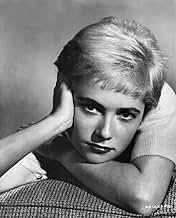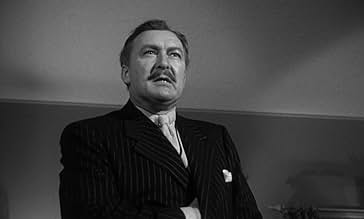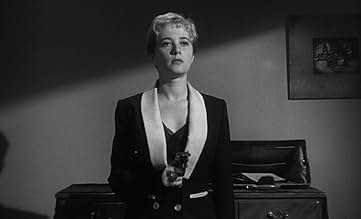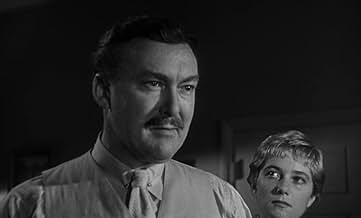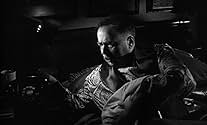IMDb रेटिंग
7.5/10
23 हज़ार
आपकी रेटिंग
अपनी भाषा में प्लॉट जोड़ेंA doomed female hitchhiker pulls Mike Hammer into a deadly whirlpool of intrigue, revolving around a mysterious "great whatsit".A doomed female hitchhiker pulls Mike Hammer into a deadly whirlpool of intrigue, revolving around a mysterious "great whatsit".A doomed female hitchhiker pulls Mike Hammer into a deadly whirlpool of intrigue, revolving around a mysterious "great whatsit".
- पुरस्कार
- 1 जीत और कुल 1 नामांकन
Marian Carr
- Friday
- (as Marion Carr)
Mady Comfort
- Nightclub Singer
- (as Madi Comfort)
फ़ीचर्ड समीक्षाएं
If The Maltese Falcon (1941) was the definitive true detective movie, The Big Sleep (1946) the definitive glamourized detective movie, and Chinatown (1974) the definitive allegorical detective movie, then Kiss Me Deadly is the definitive sleazy detective movie.
Mickey Spillane's sadistic private eye Mike Hammer, turned from successful private eye to sleazy bedroom dick, is the quintessential anti-hero, doing just about anything and everything wrong to get a piece of the pie that the characters call "The Big What's-it."
The movie survives by giving the usual Spillane buckets-of-blood story and its protagonist new dimensions. Right from the electric opening scene and the audacious opening credit sequence, the audience is drawn into Hammer's seedy world, where morality is suspended, and the credo of the end justifying the means dominates Hammer's actions. His reckless abandonment is almost never questionned and the film seems to understand his brutality as what he must do to get the job done in an equally brutal world.
Director Robert Aldrich observes all of it with an objective eye that neither glorifies nor condemns the action on-screen, letting the audience draw its own conclusions--even where the plot is concerned. The pace is unrelentless and the plot turns are never fully explained, forcing the audience to participate willingly in all that Hammer does to, hopefully, see the story through to its ending.
And what an ending! I'd de damned to a special place in Hell if I elaborated, so I'll just say that it's one of the greatest I've ever seen. That goes same for the movie itself, which is one of the most stylish, jarring and truly entertaining movies of its genre.
Mickey Spillane's sadistic private eye Mike Hammer, turned from successful private eye to sleazy bedroom dick, is the quintessential anti-hero, doing just about anything and everything wrong to get a piece of the pie that the characters call "The Big What's-it."
The movie survives by giving the usual Spillane buckets-of-blood story and its protagonist new dimensions. Right from the electric opening scene and the audacious opening credit sequence, the audience is drawn into Hammer's seedy world, where morality is suspended, and the credo of the end justifying the means dominates Hammer's actions. His reckless abandonment is almost never questionned and the film seems to understand his brutality as what he must do to get the job done in an equally brutal world.
Director Robert Aldrich observes all of it with an objective eye that neither glorifies nor condemns the action on-screen, letting the audience draw its own conclusions--even where the plot is concerned. The pace is unrelentless and the plot turns are never fully explained, forcing the audience to participate willingly in all that Hammer does to, hopefully, see the story through to its ending.
And what an ending! I'd de damned to a special place in Hell if I elaborated, so I'll just say that it's one of the greatest I've ever seen. That goes same for the movie itself, which is one of the most stylish, jarring and truly entertaining movies of its genre.
Movies like "Kiss Me Deadly" are reassuring that there's more to each genre than meets the eye. "Kiss Me Deadly" is part hard-boiled detective story & part apocalyptic sci-fi horror film. The movie suspects its own plots and its conventions are ludicrous. The result is a highly inventive film with a ridiculous but highly enjoyable storyline and comically fascinating characters.
The basic plot, loosely adapted from Mickey Spillane's bestselling novel,is: after private-eye Mike Hammer picks up a hitchhiker who is later murdered, he becomes determined to learn the truth about her death. Although the plot becomes more and more insane, it's highly interesting. There are no empty twists, as each one leads to something larger and more confounding.
I've never had more fun with a film noir character than the aptly named character of Mike Hammer. He isn't intimidated by any man and denies the world's hottest women. If he holds the upper hand in a situation, he seems virtually impenetrable. This characteristic leads to the ever-prevalent theme in film noirs of men vs. women and their places in relationships and society.
The film is a masterpiece of cinematography, exhibited in the disorienting camera angles and unique and unconventional compositions of Ernest Laszlo. In fact, Ernesto Laszlo's cinematography is so apt with the film's randomness that it made me giddy.
One of the most distinctive aspects of Kiss Me Deadly is the outrageousness of its final few seconds: the movie doesn't conclude, it detonates. In the hands of the director Robert Aldrich, the film becomes a starting point for a delirious expression of 1950s anxiety and paranoia, starting with opening credits that run backwards and ending with an atomic explosion.
The basic plot, loosely adapted from Mickey Spillane's bestselling novel,is: after private-eye Mike Hammer picks up a hitchhiker who is later murdered, he becomes determined to learn the truth about her death. Although the plot becomes more and more insane, it's highly interesting. There are no empty twists, as each one leads to something larger and more confounding.
I've never had more fun with a film noir character than the aptly named character of Mike Hammer. He isn't intimidated by any man and denies the world's hottest women. If he holds the upper hand in a situation, he seems virtually impenetrable. This characteristic leads to the ever-prevalent theme in film noirs of men vs. women and their places in relationships and society.
The film is a masterpiece of cinematography, exhibited in the disorienting camera angles and unique and unconventional compositions of Ernest Laszlo. In fact, Ernesto Laszlo's cinematography is so apt with the film's randomness that it made me giddy.
One of the most distinctive aspects of Kiss Me Deadly is the outrageousness of its final few seconds: the movie doesn't conclude, it detonates. In the hands of the director Robert Aldrich, the film becomes a starting point for a delirious expression of 1950s anxiety and paranoia, starting with opening credits that run backwards and ending with an atomic explosion.
"Kiss Me Deadly" had few similarities with Spillane's story about a gang of dope traffickers
Instead Aldrich reworks the plot so that the criminals are mixed up in the theft of priceless and high1y dangerous radioactive material which they are planning to smuggle to an unnamed power
The complicated story begins with Hammer picking up a scared girl on a lonely road at night and continues through the girl's subsequent death, a kidnapping and a series of very brutal killings
Spillane's Mike Hammer remains the ultimate in violent private eyes The killings seem to matter less than the sadism One scene in which Hammer deliberately breaks the irreplaceable records of an Italian opera lover in order to get the information he wants is more repellent than any of the murders in the film
Furious but stylish, "Kiss Me Deadly" is a film of great power and stays unique for its mixing of art and pulp fiction
Spillane's Mike Hammer remains the ultimate in violent private eyes The killings seem to matter less than the sadism One scene in which Hammer deliberately breaks the irreplaceable records of an Italian opera lover in order to get the information he wants is more repellent than any of the murders in the film
Furious but stylish, "Kiss Me Deadly" is a film of great power and stays unique for its mixing of art and pulp fiction
10Don-102
Kiss Me Deadly is an absolute joy to watch. There are no big-name stars, the director has never been mentioned in the same breath as a Hitchcock or Huston, and it's basically a simple Mickey Spillane story. How its presented on the screen is the genius of the picture. Right from the opening credit sequence, you know you're in for something fresh and innovative. This is a must see for fans of Quentin Tarantino, and there is a curious box containing a certain substance that glows when opened (Pulp Fiction, anyone?). It is one of the finest of the "film noir" genre, predominantly because of the moody black and white photography and its amazing 'timeless' appeal (I would rank it alongside Touch of Evil). It's great to know the film has been "rediscovered", and be sure to see a copy of the film containing 2 different versions of the mind-boggling final sequence shot at the time.
Robert Aldrich was a no-nonsense film director. When he undertook the direction of this film, little did he know it was going to become the extraordinary movie it turned out to be. The fame seems to have come by its discovery in France, as it usually is the case. Based on Mickey Spillane's novel and adapted by Al Bezzerides, the movie has an unique style and it's recommended viewing for fans of the film noir genre.
Right from the start, the film gets our imagination as we watch a young woman running along a California highway. That sequence proved Mr. Aldrich's ability to convey the idea of a disturbed young woman that seems to have escaped from a mental institution. The plot complicates itself as Hammer learns that Christine, the young woman, has died. He decides to investigate, which is what he does best.
Some excellent comments have been submitted to this forum, so we will not even try to expand in the action but will only emphasize in the tremendous visual style Mr. Aldrich added to the film, which seems to be its main attraction. For a fifty year old film, it still has a crisp look to it thanks to the impressive black and white cinematography of Ernest Lazlo, who had a keen eye to show us Hammer's world as he makes it come alive. The great musical score by Frank DeVol fits perfectly with the atmosphere of the L.A. of the fifties.
Ralph Meeker made an excellent contribution as Mike Hammer. He dominates the film with his presence. Albert Decker, Paul Stewart, Miriam Carr, Maxine Cooper, Fortuno Bonanova, and especially Cloris Leachman, in her screen debut, make this film the favorite it has become.
Fans of the genre can thank Mr. Aldrich for making a film that didn't pretend to be anything, yet has stayed as a favorite all these years.
Right from the start, the film gets our imagination as we watch a young woman running along a California highway. That sequence proved Mr. Aldrich's ability to convey the idea of a disturbed young woman that seems to have escaped from a mental institution. The plot complicates itself as Hammer learns that Christine, the young woman, has died. He decides to investigate, which is what he does best.
Some excellent comments have been submitted to this forum, so we will not even try to expand in the action but will only emphasize in the tremendous visual style Mr. Aldrich added to the film, which seems to be its main attraction. For a fifty year old film, it still has a crisp look to it thanks to the impressive black and white cinematography of Ernest Lazlo, who had a keen eye to show us Hammer's world as he makes it come alive. The great musical score by Frank DeVol fits perfectly with the atmosphere of the L.A. of the fifties.
Ralph Meeker made an excellent contribution as Mike Hammer. He dominates the film with his presence. Albert Decker, Paul Stewart, Miriam Carr, Maxine Cooper, Fortuno Bonanova, and especially Cloris Leachman, in her screen debut, make this film the favorite it has become.
Fans of the genre can thank Mr. Aldrich for making a film that didn't pretend to be anything, yet has stayed as a favorite all these years.
क्या आपको पता है
- ट्रिवियाThe Kefauver Commission, a federal unit dedicated to investigating corrupting influences in the 1950s, singled this out as 1955's number one menace to American youth. Because of this, Robert Aldrich felt compelled to conduct a writing campaign for the free speech rights of independent filmmakers.
- गूफ़At the beginning, Christina (Cloris Leachman) is shown running at the side of the highway, but the shots of only her feet show her running along the painted center line of the highway.
- भाव
Mike Hammer: You're never around when I need you.
Velda: You never need me when I'm around.
- क्रेज़ी क्रेडिटThe opening credits scroll down instead of the usual up, resulting in needing to read them bottom to top.
- इसके अलावा अन्य वर्जनUntil 1997, all known copies in circulation of "Kiss Me Deadly" ended rather abruptly: the wounded Mike Hammer stumbling through the beach house looking for his partner Velda, and then there's a couple of brief shots of the house exploding and burning, with "The End" superimposed on the final shot. The music is cut off instead of fading out, and the screen turns black; it looks like Mike and Velda died in the blaze.
- कनेक्शनEdited into American Cinema: Film Noir (1995)
- साउंडट्रैकRather Have the Blues
Sung by Nat 'King' Cole
Written by Frank De Vol (uncredited)
[Played on the car radio during the opening title card and credits]
टॉप पसंद
रेटिंग देने के लिए साइन-इन करें और वैयक्तिकृत सुझावों के लिए वॉचलिस्ट करें
विवरण
- रिलीज़ की तारीख़
- कंट्री ऑफ़ ओरिजिन
- भाषाएं
- इस रूप में भी जाना जाता है
- El beso mortal
- फ़िल्माने की जगहें
- Clay Street, Bunker Hill, Downtown, लॉस एंजेल्स, कैलिफोर्निया, संयुक्त राज्य अमेरिका(Mike parks his Corvette and takes the back steps up to the Hillcrest Hotel)
- उत्पादन कंपनी
- IMDbPro पर और कंपनी क्रेडिट देखें
बॉक्स ऑफ़िस
- बजट
- $4,10,000(अनुमानित)
- US और कनाडा में सकल
- $7,26,000
- दुनिया भर में सकल
- $9,52,000
- चलने की अवधि
- 1 घं 46 मि(106 min)
- रंग
- पक्ष अनुपात
- 1.85 : 1
इस पेज में योगदान दें
किसी बदलाव का सुझाव दें या अनुपलब्ध कॉन्टेंट जोड़ें



